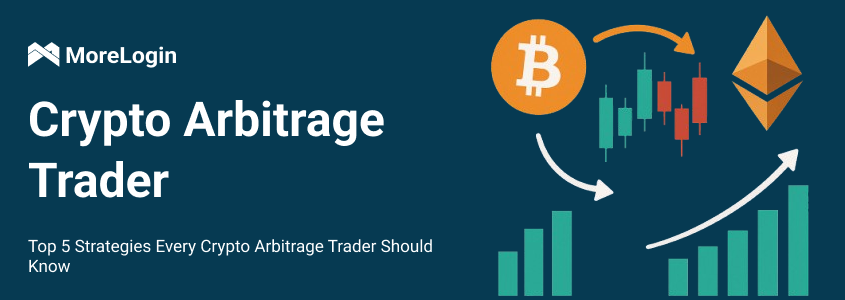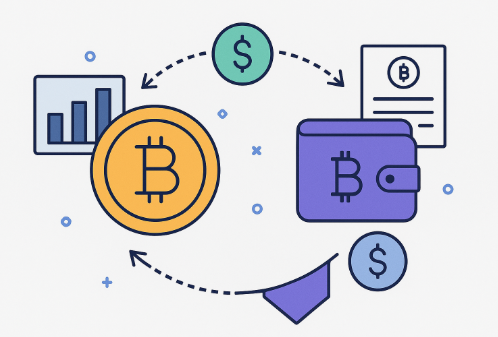
- Product

- Pricing
- Affiliate Program
- Use Cases
- Resource


To succeed as a Crypto Arbitrage Trader, you need more than finding price gaps between exchanges. You also need strategies to cut risk, trade faster, and boost returns in real time. This guide shares five key strategies: multi-platform monitoring, automated trading, cost optimization, risk control, and timing to help you build a stable and profitable model.
Crypto arbitrage means earning from the price gap of the same cryptocurrency on different platforms. For example, if Bitcoin is $30,000 on exchange A and $30,100 on exchange B, you could buy on A and sell on B for a $100 difference. But that’s before fees, transaction, withdrawal, and transfer costs cut into it.
It has a few benefits. Unlike trend trading, you don’t need long-term market forecasts, so market exposure is lower. Opportunities can appear often, especially in volatile or less liquid pairs. In many cases, you know the price difference before trading, which helps control risk.
Still, there are risks. Latency can kill a trade — even a few seconds’ delay in execution or moving funds can erase the gap. Fees add up fast. Big trades may cause slippage, pushing prices against you. And rules or limits from exchanges, like withdrawal caps, outages, or halts, can trap your funds.
For a crypto arbitrage trader, this isn’t “free money.” Success comes from speed, tight cost control, and a reliable trading setup.
To outperform the market and reduce risks, every crypto arbitrage trader should implement these five strategic practices.
![]()
Arbitrage depends on finding price differences between trading platforms. This process requires real-time data, quick decision-making, and a broad view of various exchanges. Tools such as Coingecko and CoinMarketCap provide general market data, while Coingapp, ArbiTool, and ArbMatrix focus on tracking arbitrage opportunities. Some traders use custom APIs to collect data directly from exchanges for faster access.
A typical setup involves monitoring 5 to 10 exchanges at the same time. Alerts are often set to track specific price spread percentages. Both centralized exchanges (CEXs) and decentralized exchanges (DEXs) are included in the observation, especially when dealing with volatile or low-liquidity trading pairs. A system that can react within seconds often provides a competitive advantage in arbitrage trading.
In crypto arbitrage, manual trading can’t keep up with the speed and volume of opportunities, so automation is a must. Bots work 24/7, react instantly, and follow code-based rules that cut down on mistakes. This means one trader can handle dozens of market pairs at once.
Platforms like HaasOnline offer deep customization for advanced users, Bitsgap is easier for beginners and works with many exchanges, and Gimmer lets you build strategies without writing code. Some experienced traders prefer building their own bots with Python and APIs from exchanges such as Binance, OKX, or Kraken.
A good automated strategy should calculate spreads after fees, filter out trades when volatility is too high, and confirm every order with rollback checks to avoid bad fills.
Controlling costs is essential for successful arbitrage. Many trades that appear profitable can actually result in losses once fees are considered. There are several common types of fees to watch out for. Trading fees usually range from 0.1% to 0.2% per transaction. Withdrawal fees are fixed and vary depending on the coin and the exchange. Additionally, blockchain fees—especially on the Ethereum network—can become very expensive during periods of high traffic.
To reduce these costs, traders should consider using exchanges that offer tiered fee structures or loyalty discounts. Whenever possible, it’s wise to choose TRC-20 or BEP-20 networks instead of ERC-20, as they tend to be much cheaper. Consolidating trades can also help prevent fragmented balances, which makes fund management easier and more cost-effective.
For example, a USDT arbitrage loop involving Binance, KuCoin, and OKX can be much cheaper if funds are transferred via the TRC-20 network. This method often costs less than $1, compared to over $20 using the ERC-20 network. Efficient routing of funds is crucial for every successful crypto arbitrage strategy.
Even with automated tools and real-time monitoring, arbitrage trading still carries risks. Common issues include exchange downtime for maintenance, transfer delays due to network congestion, and fund freezes due to unverified accounts.
The first step to reducing risk is not to hold all your funds on a single exchange. Instead, spread your funds across multiple platforms, keeping each holding between 20% and 30%. When transferring funds across platforms, try using stablecoins to reduce price volatility and speed up the transfer of funds.
Before executing a trade, run the arbitrage path in a simulated environment to confirm that it can be completed within the expected timeframe. If a trade times out for more than a few seconds, cancel it immediately. Maintain separate funds for different strategies, such as arbitrage between centralized exchanges, arbitrage between centralized and decentralized exchanges, and arbitrage between decentralized exchanges.
Sound risk management not only reduces losses but also determines a crypto arbitrage trader's ability to maintain long-term profitability.
The cryptocurrency market is always open, but good arbitrage opportunities are not evenly distributed. Overlapping trading sessions, such as between the European and US trading sessions, can lead to widening spreads. Major news events, Federal Open Market Committee (FOMC) decisions, Securities and Exchange Commission (SEC) decisions, ETF prices, and significant fluctuations in token supply can also cause sharp drops in interest rates. On-chain events, such as protocol changes and airdrops, often have similar effects.
A crypto arbitrage trader needs fast and reliable data to capitalize on these opportunities. Follow active sources like @WuBlockchain and @WhaleChart on Twitter, stay up-to-date on developments in their Telegram channel, and monitor aggregators like CryptoPanic and CoinDesk. When planning your trading plan, crypto arbitrage trading often involves wider spreads and higher profits.

Morelogin is a practical tool that helps crypto traders, marketers, and operational teams manage multiple accounts with ease.. The Morelogin article on arbitrage creatives explains how the platform enables secure, scalable arbitrage trading by helping users manage multiple accounts and avoid platform bans.
For arbitrage traders, Morelogin offers a multi-login environment that allows them to manage more than 10 exchange accounts simultaneously. It also includes browser fingerprint masking, which reduces the risk of account bans on platforms that restrict duplicate access. Additionally, isolated cookie sessions help prevent session conflicts and unintended logouts during concurrent operations.
This tool is particularly useful for crypto arbitrage traders because it enables them to run bots or perform manual trade loops across multiple accounts without causing operational overlap. The platform also supports separate environments tailored for CEXs, DEXs, wallets, client systems, and internal tools. By providing this flexibility, Morelogin empowers teams to scale their arbitrage operations efficiently, eliminating the need for additional personnel.
Successful crypto arbitrage traders follow a clear plan: watch the market in real time, automate trades, control costs, manage risks, and time entries well. These five steps keep trading fast, efficient, and safer. Since the market changes quickly, keep refining your approach and adapting. Tools like Morelogin can help run operations smoothly and manage multiple accounts for better results.